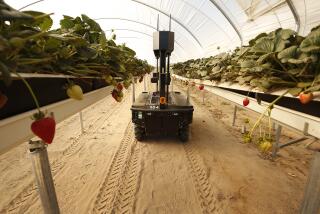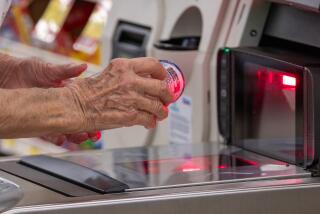County Proposes Vending Machines to Dispense Food Stamps
Searching for a more efficient way to distribute food stamps than through the U.S. mail, San Diego County welfare officials think theyâve found the answer: automatic teller machines.
Much like those used by bank customers, the machines would cut by almost half what it costs the county to distribute about $3 million in food stamps each month, said Vicky Pion, director of the project for the county Department of Social Services.
While the new machines might be neither as convenient nor as safe as the certified mail used for 70% of the countyâs food stamp recipients today, they would be spread geographically across the county in secure, well-traveled locations, probably in the lobbies of private check-cashing outlets, Pion said.
Nine of the machines could be in place by spring, making San Diego the first county in the nation to use such a system, Pion said.
The proposal, which still must gain state and federal approval, is the latest innovation in the countyâs food stamp program, best known for its controversial âworkfareâ system that requires food stamp recipients to work for their aid.
The county is developing the automatic teller concept under pressure from the state, which wants every county to adopt an automated system that is already in place in two counties or find other ways of distributing the stamps that can be proven even more efficient.
The model used in San Francisco and Fresno counties requires food stamp recipients to present a plastic card, much like a modern bank card, to a clerk, who then inserts it into a card-reading machine, gets the recipientâs allotment of stamps, and hands them across the counter to the client.
That process, while automating the welfare programâs accounting, still requires the use of county or contract employees to distribute the stamps. San Diegoâs program would go a step further by eliminating the middle man, giving recipients direct access to their food stamps.
Pion said the teller machines would be more convenient than certified mail for food stamp recipients who work. Under the current set-up, clients who are not home when their stamps are delivered must go to the post office during working hours. The automatic tellers will be available several nights a week.
The countyâs system would be put in place with a bare-bones approach, beginning with a three-month pilot project in one of the countyâs district offices.
âWe certainly donât want to install nine ATMâs and then find out that people simply wonât use them,â Pion said.
Any frills would be added after the automatic teller machines were a proven success. Later, for example, the machines might be placed in grocery stores rather than check-cashing offices.
âWeâre trying to eliminate as many political problems as possible,â Pion said. âWe want to get the system up and running and then turn to the markets. We donât need anything to stop us now.â
Pion said future changes might also include at least one machine that would be accessible 24 hours a day. Recipients might also be allowed to withdraw food stamps in varying amounts, much as they would take cash from a savings account. Current plans would require clients to receive their entire allotment of stamps in one transaction.
The ATM system would cut the countyâs cost of distributing food stamps from $662,000 a year to about $400,000, including the cost of paying a bonded, private contractor to place the stamps in the machines. Postage alone now costs the county almost $400,000 a year.
More to Read
Sign up for Essential California
The most important California stories and recommendations in your inbox every morning.
You may occasionally receive promotional content from the Los Angeles Times.










